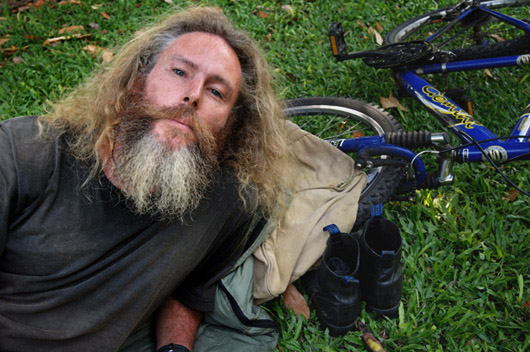A.bc
In Australia, sulle tracce di Chatwin 20 anni dopo Le Vie dei Canti
Palazzo delle Esposizioni, Roma
A.bc
In Australia, in Chatwin's footsteps 20 years after The Songlines Palazzo
Delle Esposizioni, Rome


La
frontiera abita qui. Al margine superiore del continente rosso affacciato
sull’Asia. In questa città che vanta più di 100 nazionalità,
giovane e moderna perché ricostruita dopo la seconda guerra mondiale
e le devastazioni del ciclone Tracy che la colpì terribilmente
la vigilia di Natale del 1974. Un centro squadrato, ordinato e vivace,
con supermercati, banche, grandi alberghi, posti per backpackers, ristorantini,
e una miriade di case sparse nella vegetazione tropicale. Darwin è
la capitale del Northern Territory, la gente che vive qui ha un’età
media di 30 anni, cinque in meno di quella nazionale, e detiene il record
mondiale del maggior consumo di birra pro-capite. Forse per il clima,
caldo tutto l'anno, a volte umidissimo. Si sta molto all’aperto,
per strada; anche le moltitudini di visitatori di passaggio tra il parco
nazionale del Kakadu e il centro rosso di Uluru. Aaron ha 42 anni, contempla
i giochi d’acqua della fontana dell’orto botanico di Darwin,
sdraiato tra un ficus gigantesco e l’onnipresente albero della gomma.
La bicicletta abbandonata a terra, il piccolo zaino sotto a far da cuscino,
gli stivaletti accanto. Capelli chiari, occhi celesti, in viaggio. Per
un attimo fa venire in mente il famoso ritratto che Lord Snowdon fece
a Bruce Chatwin nel 1982, con gli scarponi e lo zaino sulle spalle, e
che ha contribuito non poco all’edificazione del mito Chatwin scrittore-viaggiatore.
Da dove viene? Da nessuna parte in particolare e, specularmente, non va
in alcun luogo preciso. Non fugge da niente, evitando il clichè,
prende distanza, cerca una misura «a metà della mia vita».
Indica l’orizzonte sul Mar di Timor, le isole al largo, l’annuncio
dell’Indonesia e di Papua Nuova Guinea più in là.
«Mi piace stare vicino alla frontiera, apre la mente. Un giorno
ripartirò»
The
border lives here. On the upper edge of the red continent facing Asia.
In this city that boasts more than 100 nationalities, young and modern
because it was rebuilt after the Second World War and the devastation
of the Cyclone Tracy which struck it terribly on Christmas Eve 1974. An
orderly and lively centre, with supermarkets, banks, large hotels, places
for backpackers, restaurants, and a myriad of houses scattered in tropical
vegetation. Darwin is the capital of the Northern Territory, the average
age of the people who live here is 30, five years younger than the national
average, and the population holds the world record for the highest consumption
of beer per capita. Maybe because of the climate, warm all year round,
sometimes very wet. They spend a lot of time outdoors, on the street;
including the crowds of visitors in transit between the Kakadu National
Park and the Red Centre of Uluru. Aaron, 42 years old, gazes at the water
fountain in the Darwin Botanical Gardens, lying down in the grass between
a gigantic ficus tree and a rubber tree. For a moment, with his bike left
beside him, his backpack as a pillow, his boots nearby, he recalls the
famous portrait of Bruce Chatwin with his boots and a backpack on his
shoulders that Lord Snowdon took in 1982 and that contributed to the creation
of the myth of the writer-traveller Chatwin. Where is he from? From nowhere
in particular and, at the same time, he is not going to any specific place.
He isn't running away from anything, avoiding clichés, he keeps
his distance, he seeks a measure «in the middle of my life».
He points at the horizon on the Timor Sea, the islands off the coast,
the announcement of Indonesia and Papua New Guinea farther ahead. «I
like staying close to the border, it opens the mind. One day, I’ll
leave again»